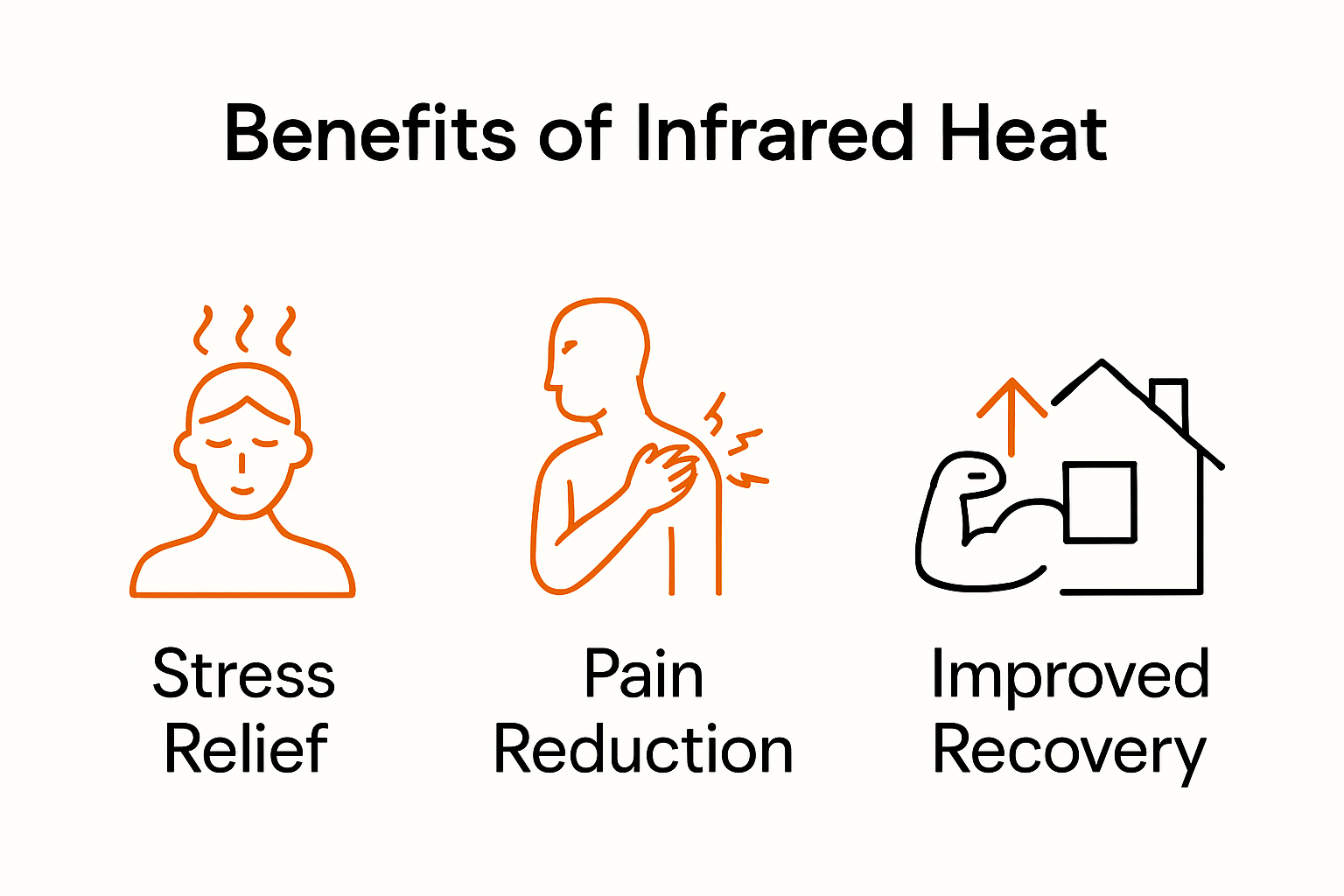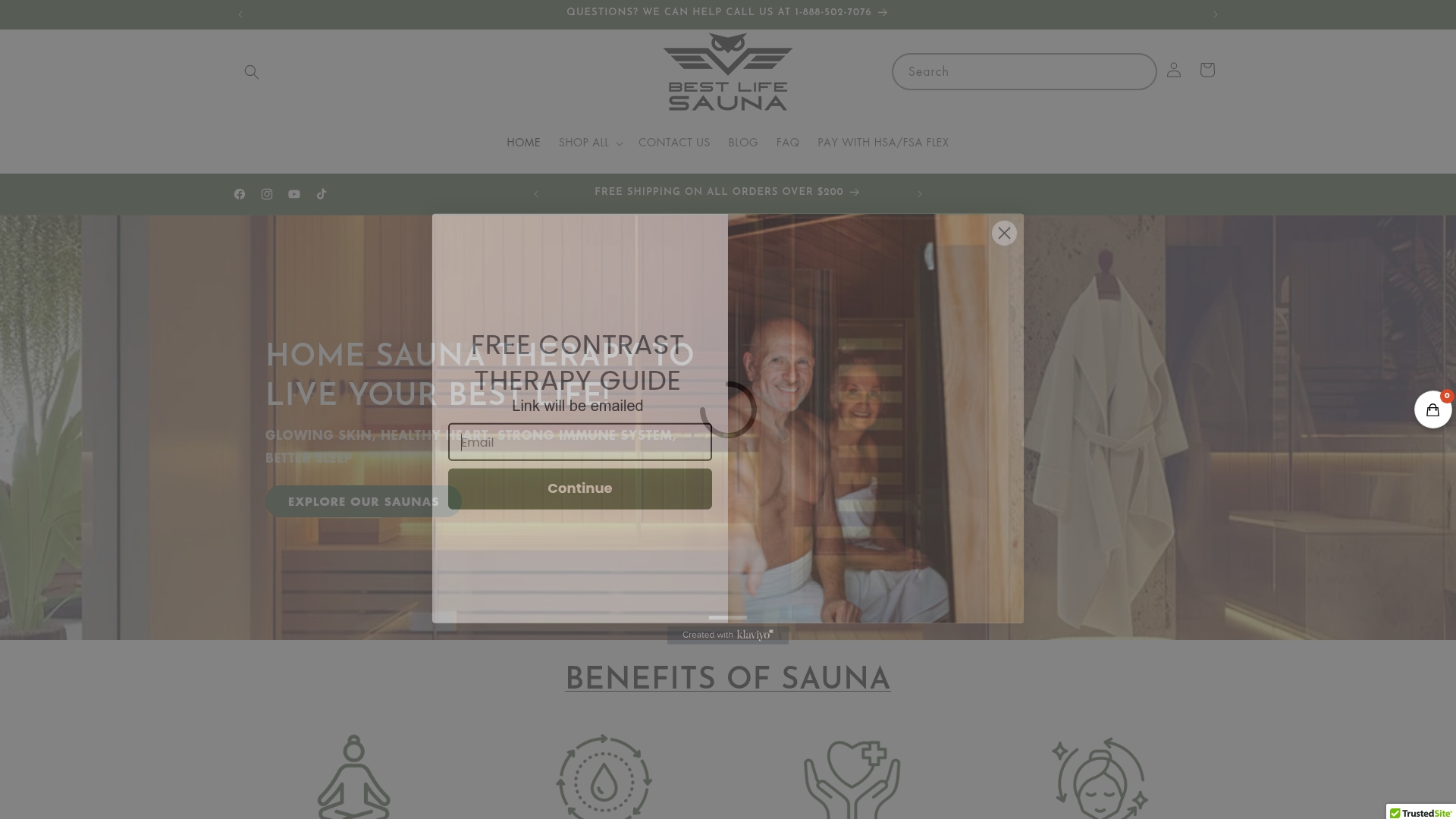
Top Benefits of Infrared Heat for Wellness and Recovery 2025

Infrared heat is quickly becoming the go-to wellness hack, and with good reason. Studies show regular infrared heat sessions can slash chronic pain by 57 percent and inflammation-related pain by up to 78 percent. Sounds impressive, right? Here’s the catch. Most people think it’s all about muscle relief, but that barely scratches the surface. The real surprise is how infrared heat reshapes your body’s stress response, improves your mood, and turns your living room into a private wellness retreat—all with the technology that’s taking off in homes across the country.
Table of Contents
- Infrared Heat For Relaxation And Stress Relief
- Supporting Physical Health: Pain Relief And Recovery
- Infrared Heat In Modern Homes And Wellness Spaces
- Choosing The Right Infrared Solutions For Your Needs
Quick Summary
| Takeaway | Explanation |
|---|---|
| Infrared Heat Promotes Stress Relief | Regular exposure to infrared heat helps reduce stress by facilitating the body’s physiological relaxation response and improving autonomic nervous system balance, as evidenced by studies linking it to lower stress-related conditions and better mood regulation. |
| Effective Pain Management Tool | Infrared heat therapy has demonstrated significant pain relief capabilities, with studies showing substantial reductions in chronic pain and inflammation, making it a valuable non-invasive option for recovery and muscle relaxation. |
| Home Integration for Wellness | The growing market for infrared technologies reflects a shift toward home-based wellness solutions, enabling individuals to create personalized, accessible recovery environments that offer professional-grade therapeutic benefits in a residential setting. |
| Personalized Selection of Infrared Solutions | Understanding the different types of infrared technologies (near, mid, and far-infrared) is crucial for effective treatment, allowing users to choose solutions that best match their specific health goals and needs. |
| Consult Medical Professionals | It’s important to seek professional advice before starting infrared therapy, particularly for individuals with pre-existing health conditions, to ensure safety and maximize therapeutic effectiveness. |

Infrared Heat for Relaxation and Stress Relief
Modern life bombards us with constant stressors that strain our mental and physical well-being. Infrared heat therapy emerges as a powerful solution for managing stress and promoting deep relaxation, offering a natural approach to restoring balance in our increasingly hectic world.
Understanding Stress Reduction Mechanisms
Infrared heat works uniquely to combat stress by engaging the body’s physiological relaxation response. Research in JAMA Internal Medicine demonstrates that regular sauna users experience a lower risk of stress-related conditions. This occurs through multiple interconnected pathways that transform how our nervous system responds to environmental challenges.
The deep penetrating warmth triggers the release of endorphins, our body’s natural mood elevators. Unlike surface-level heating methods, infrared technology allows heat to penetrate several inches into muscle tissue, creating a comprehensive relaxation effect. This deep tissue warming stimulates circulation, encourages muscle tension release, and signals the brain to transition from a high-stress sympathetic state to a calm parasympathetic state.
Neurological and Physiological Benefits
According to findings published in the Journal of Human Kinetics, infrared heat therapy improves autonomic nervous system balance through enhanced heart rate variability. This key marker of stress resilience indicates that consistent infrared heat exposure can fundamentally reshape how our body manages stress.
The therapeutic process involves complex interactions between thermal stimulation and neurological responses. When exposed to gentle infrared heat, the body initiates a cascade of physiological changes. Blood vessels dilate, improving circulation and oxygen delivery. Cortisol levels begin to decrease, while serotonin and dopamine production increases. These neurochemical shifts contribute to a profound sense of calm and emotional equilibrium.

Practical Stress Management Strategy
Integrating infrared heat sessions into your wellness routine offers a strategic approach to stress management. Consistent exposure creates cumulative benefits, training your body to respond more effectively to stressors. Recommended session lengths typically range from 20 to 45 minutes, allowing sufficient time for deep thermal penetration and neurological recalibration.
Individuals experiencing chronic stress, anxiety, or tension can find significant relief through this non-invasive approach. The gentle, enveloping warmth provides a meditative environment that encourages mental reset and physical recovery. By addressing stress at both neurological and muscular levels, infrared heat therapy represents a holistic wellness solution.
While individual experiences may vary, the scientific evidence supporting infrared heat’s stress-reduction capabilities continues to grow. Complementary Therapies in Medicine validates significant stress level reductions among regular users, highlighting the potential of this innovative therapeutic approach.
As our understanding of stress management evolves, infrared heat emerges not just as a treatment but as a proactive strategy for maintaining mental and physical resilience in an increasingly demanding world.
Supporting Physical Health: Pain Relief and Recovery
Physical discomfort and muscle recovery represent significant challenges for athletes, chronic pain sufferers, and individuals seeking optimal wellness. Infrared heat therapy offers a groundbreaking approach to addressing these complex physiological needs through targeted, deep-penetrating healing mechanisms.
Comprehensive Pain Management Strategies
Research from Gladiator Therapeutics indicates that infrared therapy encourages muscle relaxation and triggers vasodilation, which increases blood flow and helps relieve sore muscles, spasms, and tension-related pain. This therapeutic approach goes beyond surface-level treatment, penetrating deep into muscle tissues to address pain at its source.
Far infrared heat treatment has demonstrated remarkable clinical outcomes. A specialized study revealed a 57% decrease in pain for patients with chronic low back pain lasting over six years, and also led to a 20% decrease in rheumatoid finger joint stiffness at therapeutic temperatures. These findings underscore the potential of infrared heat as a powerful non-invasive pain management solution.
Inflammation Reduction and Recovery Acceleration
Beyond pain relief, infrared heat plays a crucial role in supporting the body’s natural recovery processes. Research published in medical journals demonstrates that infrared saunas may help reduce inflammation and enhance recovery, providing significant benefits for individuals dealing with chronic pain conditions and seeking improved physical performance.
The mechanism behind this recovery support involves complex physiological responses. When exposed to infrared heat, blood vessels dilate, improving circulation and oxygen delivery to damaged or stressed tissues. This enhanced blood flow accelerates the removal of metabolic waste, reduces inflammation, and supports faster healing of muscle microtrauma resulting from intense physical activity.
Targeted Healing for Different Pain Conditions
Infrared heat therapy demonstrates versatility in addressing various pain conditions. Athletes can utilize this technology for muscle recovery, while individuals with chronic conditions like arthritis may experience significant relief. The non-invasive nature of infrared heat makes it an attractive alternative to traditional pain management approaches.
Typical therapeutic sessions range from 20 to 45 minutes, allowing sufficient time for deep thermal penetration and physiological response. Users often report not just pain reduction but also improved flexibility, reduced muscle stiffness, and an overall sense of physical well-being.
While individual responses may vary, the growing body of scientific evidence supports infrared heat as a promising approach to pain management and physical recovery. Its ability to address pain at a cellular level, without the side effects associated with pharmaceutical interventions, positions it as an innovative wellness strategy.
As medical understanding continues to evolve, infrared heat therapy represents a sophisticated, scientifically-backed method for supporting physical health, offering hope and relief for those navigating complex pain management challenges.
To help summarize the key clinical outcomes and benefits of infrared heat therapy highlighted in this section, the following table compiles major statistics and findings discussed above:
| Benefit or Outcome | Study or Source | Reported Effect/Statistic |
|---|---|---|
| Pain relief for chronic low back pain | Specialized Study (Fireactiv) | 57% decrease in pain |
| Reduction in rheumatoid joint stiffness | Specialized Study (Fireactiv) | 20% decrease at therapeutic temperatures |
| Relief for inflammation-linked pain | Gladiator Therapeutics | Up to 78% reduction in pain |
| Muscle relaxation and vasodilation | Gladiator Therapeutics | Increased blood flow, reduced soreness |
| Inflammation reduction & recovery support | Medical Journal (KevinMD) | Enhanced recovery, less inflammation |
| Improved flexibility and decreased stiffness | Multiple sources | Reported by regular users after 20-45 min. sessions |
Infrared Heat in Modern Homes and Wellness Spaces
The integration of wellness technologies into residential and personal spaces represents a transformative approach to health management. Infrared heat technology has emerged as a pivotal innovation, reshaping how individuals conceptualize home-based wellness and personal recovery strategies.
Market Evolution and Home Integration
Global market research projects the infrared sauna market will reach $3.58 billion by 2032, reflecting a significant shift in consumer attitudes toward home-based wellness solutions. This growth signals a profound change in how individuals perceive health maintenance and personal care within their living environments.
Modern home wellness spaces are no longer confined to traditional exercise rooms or dedicated spa areas. Infrared heat technologies now offer compact, versatile solutions that can be seamlessly integrated into various home settings. Portable infrared devices, compact personal saunas, and multi-functional wellness panels provide unprecedented accessibility for individuals seeking therapeutic heat experiences without extensive space requirements.
Clinical Benefits in Personal Environments
According to the Mayo Clinic, infrared saunas in residential settings provide multiple health benefits including improved circulation, muscle relaxation, and enhanced overall well-being. These therapeutic advantages transform home spaces into personal wellness sanctuaries.
The clinical potential of home-based infrared heat is substantial. Research from Gladiator Therapeutics demonstrates remarkable outcomes, with studies indicating up to 78% reduction in pain for individuals with inflammation-linked conditions. This transformative potential means that personal wellness spaces can now offer medical-grade therapeutic experiences without leaving home.
Design and Technological Innovations
Contemporary infrared heat technologies prioritize user experience through intelligent design and technological integration. Smart controls, customizable temperature settings, and compact form factors allow users to create personalized wellness environments that adapt to individual health needs and spatial constraints.
Home infrared solutions now range from full-body saunas to targeted healing panels, providing flexibility for diverse user requirements. Some advanced systems incorporate additional features like chromotherapy lighting, bluetooth connectivity for music or guided meditation, and precise temperature and humidity controls.
The democratization of wellness technology means individuals can now access professional-grade therapeutic experiences within their personal spaces. Infrared heat represents more than a treatment method it symbolizes a holistic approach to health that emphasizes prevention, recovery, and daily self-care.
As healthcare continues to embrace personalized, proactive strategies, home-based infrared heat technologies stand at the forefront of a broader wellness revolution. They offer not just a therapeutic intervention, but a comprehensive approach to maintaining physical and mental equilibrium in our increasingly complex modern world.
Choosing the Right Infrared Solutions for Your Needs
Selecting the most appropriate infrared solution requires a nuanced understanding of personal health goals, technological capabilities, and individual wellness needs. Infrared heat technology offers a spectrum of options, each designed to address specific health and recovery objectives.
To clarify the unique features and therapeutic advantages of the main types of infrared technologies discussed, the following table compares near, mid, and far-infrared wavelengths and their common applications:
| Type of Infrared | Penetration Depth | Main Benefits | Typical Applications |
|---|---|---|---|
| Near-Infrared | Surface (skin level) | Skin rejuvenation, surface tissue repair | Skin health, wound healing |
| Mid-Infrared | Deeper (muscle/joint) | Targets muscle/joint inflammation, deep heating | Muscle recovery, joint therapy |
| Far-Infrared | Deepest (organs/tissue) | Metabolic, cardiovascular, full-body relaxation | Sauna, cardiovascular support |
Understanding Infrared Technology Types
Research from the Mayo Clinic emphasizes the importance of understanding different infrared technologies. Three primary types exist: near-infrared, mid-infrared, and far-infrared, each penetrating the body at different depths and providing unique therapeutic benefits.
Near-infrared wavelengths offer surface-level healing and are excellent for skin rejuvenation and surface tissue repair. Mid-infrared wavelengths penetrate deeper, targeting muscle and joint inflammation. Far-infrared wavelengths reach the deepest tissue levels, providing comprehensive metabolic and cardiovascular benefits. The key is matching the technology to your specific wellness objectives.
Personalized Selection Criteria
Specialized therapeutic research reveals that optimal infrared therapy requires precise temperature control. The therapeutic temperature range typically sits around 45°C (112°F) for maximum joint and muscle benefits. When selecting an infrared solution, consider factors such as:
- Temperature Customization: Ability to adjust heat levels
- Size and Portability: Home versus professional unit requirements
- Wavelength Specificity: Targeted healing capabilities
- Safety Certifications: Ensuring technological reliability
Medical Considerations and Professional Guidance
Healthcare experts recommend consulting medical professionals before initiating infrared therapy, particularly for individuals with pre-existing cardiovascular conditions or chronic health challenges. A thorough medical consultation ensures that your chosen infrared solution aligns safely with your individual health profile.
Individuals with heart conditions, pregnancy, or certain neurological disorders should undergo comprehensive medical screening. Some infrared technologies might require modifications or might not be suitable for specific health scenarios. Professional medical guidance can help navigate these nuanced considerations, ensuring both safety and therapeutic effectiveness.
The landscape of infrared wellness solutions continues to evolve, with technological innovations providing increasingly sophisticated and personalized options. From compact personal devices to full-body therapeutic systems, the market offers solutions catering to diverse wellness needs.
Ultimately, choosing the right infrared solution is a personal journey of understanding your body’s unique requirements. By combining technological knowledge, medical insights, and personal wellness goals, you can select an infrared solution that truly transforms your health and recovery experience.
Frequently Asked Questions
What are the benefits of infrared heat therapy?
Infrared heat therapy promotes stress relief, reduces chronic pain by up to 57%, and helps decrease inflammation-related pain by up to 78%. It supports relaxation, muscle recovery, and overall wellness.
How does infrared heat affect stress levels?
Infrared heat engages the body’s relaxation response, improving autonomic nervous system balance. This can lead to a decrease in stress-related conditions, improve mood, and enhance overall emotional well-being.
What types of infrared technology are available for home use?
There are three main types of infrared technology: near-infrared, mid-infrared, and far-infrared. Each type penetrates the body at different depths and offers unique benefits, from skin rejuvenation to deep tissue relaxation.
Is infrared heat therapy safe for everyone?
While generally safe, it’s essential to consult with a medical professional before starting infrared therapy, especially for individuals with pre-existing health conditions like cardiovascular issues or pregnancy.
Elevate Your Wellness Journey With Real Infrared Solutions
Are you tired of struggling with lingering stress, stubborn pain, or slow recovery that holds you back from living your healthiest life? This article highlighted how infrared heat therapy can help relax the mind, accelerate recovery, and provide long-lasting relief from chronic aches. But the science of wellness means little without the right tools in your own home.

Take the next step and bring these benefits into your daily routine. At Best Life Sauna, you will discover premium infrared saunas and accessories designed to maximize relaxation, support muscle recovery, and help you manage stress naturally. Our friendly team is here to answer your questions and help you choose the perfect solution for your goals. Do not wait for wellness to come to you. Explore the Best Life Sauna experience now and reclaim your comfort, balance, and vitality today.

